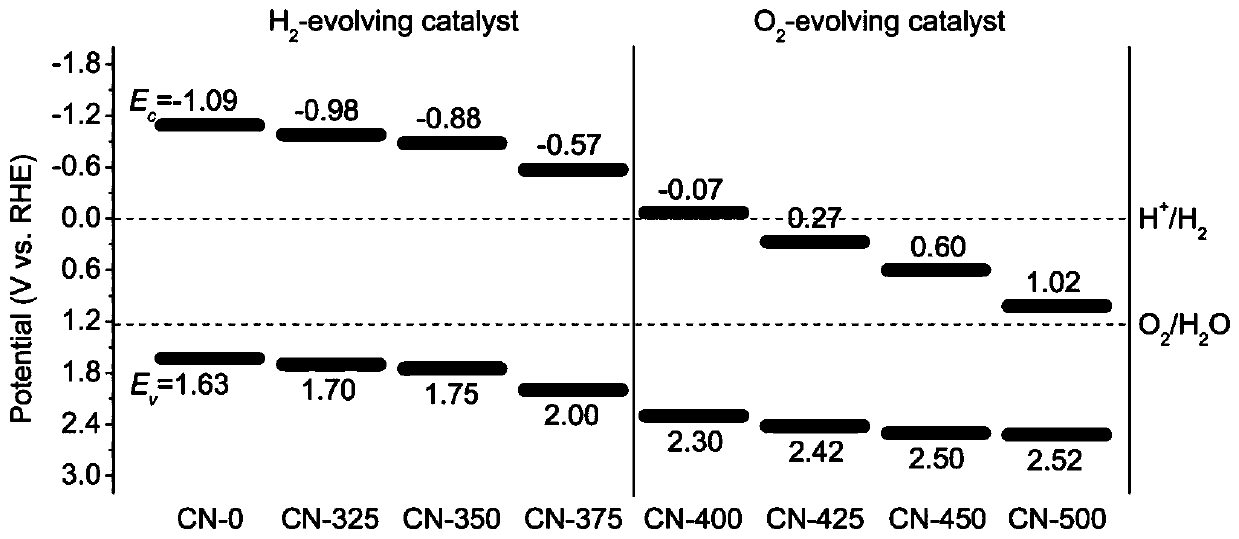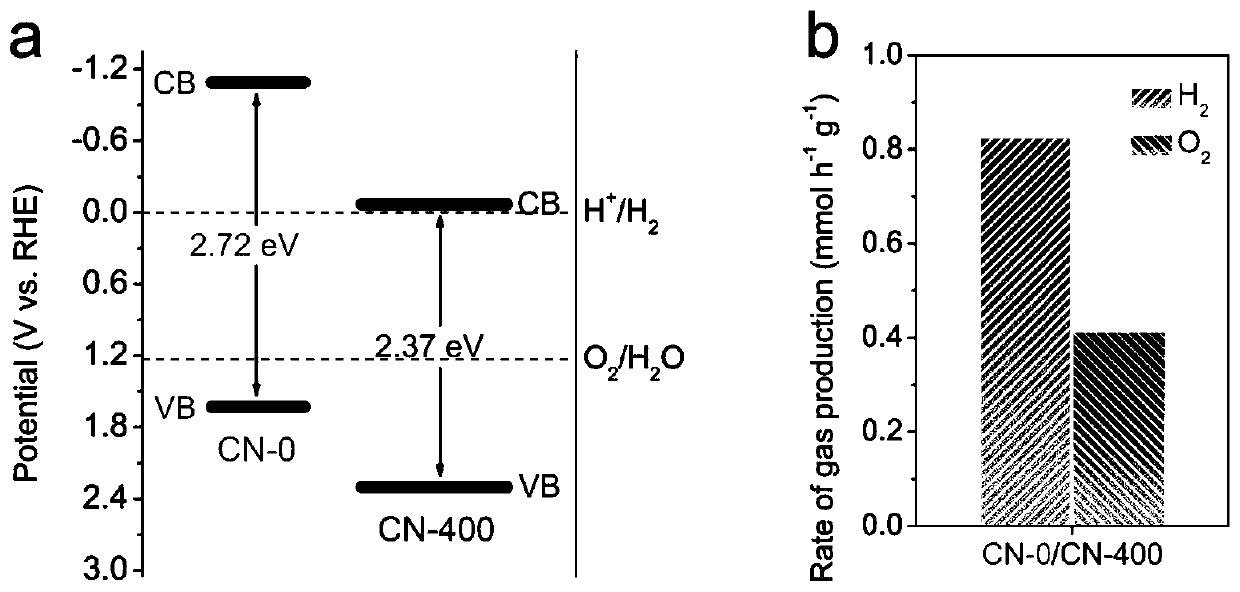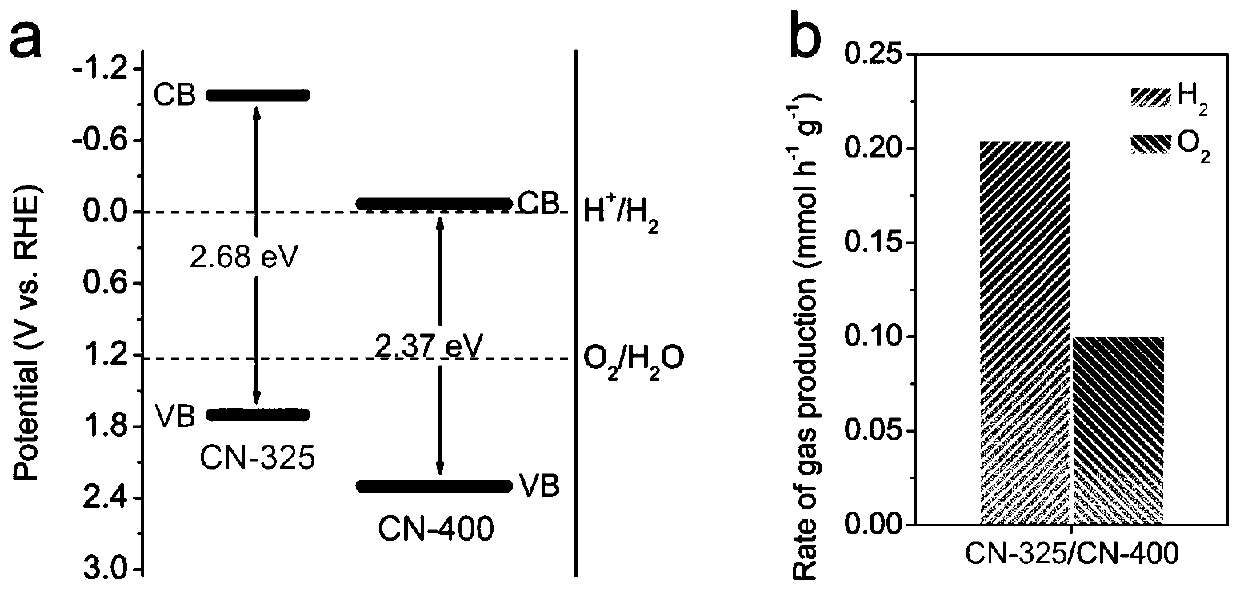Preparation method and application of carbon nitride ultrathin heterojunction
A heterojunction, carbon nitride technology, applied in chemical instruments and methods, nitrogen compounds, nitrogen and non-metallic compounds, etc., can solve the problem of low driving force of oxidation/reduction reaction, full water splitting performance needs to be improved, carrier Problems such as slow transmission, to avoid environmental pollution problems, cheap raw materials, and simple methods
- Summary
- Abstract
- Description
- Claims
- Application Information
AI Technical Summary
Problems solved by technology
Method used
Image
Examples
Embodiment 1
[0037] 1), such as figure 2 As shown in a, 0.5 g of negatively charged ultrathin hydrogen-producing g-C 3 N 4 (CN-0) was added to 200 mL of aqueous hydrochloric acid solution with a concentration of 1.5 mol / L, followed by ultrasonication for 1 h, stirring vigorously at a speed of 700 r / min for 4 h, then filtering and washing until the supernatant was neutral, and finally vacuum drying to remove water;
[0038] 2), 0.05g negatively charged ultra-thin oxygen-producing g-C 3 N 4 (CN-400) and 0.05g of the positively charged ultrathin hydrogen-producing g-C obtained in step 1) 3 N 4 (CN-0) was added to 200mL deionized water, followed by ultrasonication for 0.5h and vigorous stirring at a speed of 700r / min for 4h. Finally, the water was removed by rotary evaporation to obtain the target product carbon nitride ultrathin heterojunction. The photolytic water splitting performance such as figure 2 as shown in b.
Embodiment 2
[0040] 1), such as image 3 As shown in a, 0.4 g of negatively charged ultrathin hydrogen-producing g-C 3 N 4 (CN-325) was added to 200mL of 1.5mol / L aqueous hydrochloric acid solution, ultrasonically ultrasonicated for 1h, stirred vigorously at a speed of 800r / min for 3h, then filtered and washed until the supernatant was neutral, and finally vacuum-dried to remove water;
[0041] 2), 0.1g negatively charged ultra-thin oxygen-producing g-C 3 N 4 (CN-400) and 0.1 g of the positively charged ultrathin hydrogen-producing g-C obtained in step 1) 3 N 4 (CN-325) was added to 200mL deionized water, followed by ultrasonication for 0.5h and vigorous stirring at a speed of 800r / min for 3h. Finally, the water was removed by rotary evaporation to obtain the target product carbon nitride ultra-thin heterojunction. This heterojunction The photolytic water splitting performance such as image 3 as shown in b.
Embodiment 3
[0043] 1), such as Figure 4 As shown in a, 0.6 g of negatively charged ultrathin hydrogen-producing g-C 3 N 4 (CN-375) was added to 250 mL of aqueous hydrochloric acid solution with a concentration of 1.5 mol / L, ultrasonically for 1 h, and vigorously stirred at a speed of 800 r / min for 4 h, then filtered and washed until the supernatant was neutral, and finally vacuum-dried to remove water;
[0044] 2), 0.1g negatively charged ultra-thin oxygen-producing g-C 3 N 4 (CN-450) and 0.1 g of the positively charged ultrathin hydrogen-producing g-C obtained in step 1) 3 N 4 (CN-375) was added to 250mL of deionized water, followed by ultrasonication for 0.5h and vigorous stirring at a speed of 800r / min for 4h. Finally, the water was removed by rotary evaporation to obtain the target product carbon nitride ultrathin heterojunction. This heterojunction The photolytic water splitting performance such as Figure 4 as shown in b.
PUM
 Login to View More
Login to View More Abstract
Description
Claims
Application Information
 Login to View More
Login to View More - Generate Ideas
- Intellectual Property
- Life Sciences
- Materials
- Tech Scout
- Unparalleled Data Quality
- Higher Quality Content
- 60% Fewer Hallucinations
Browse by: Latest US Patents, China's latest patents, Technical Efficacy Thesaurus, Application Domain, Technology Topic, Popular Technical Reports.
© 2025 PatSnap. All rights reserved.Legal|Privacy policy|Modern Slavery Act Transparency Statement|Sitemap|About US| Contact US: help@patsnap.com



